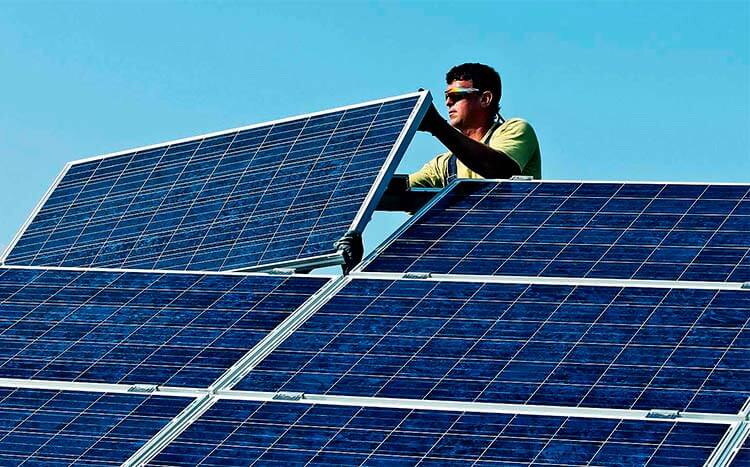Home Solar Panel Temperatures
Solar Panel Temperatures: When Affects Efficiency (Coefficient)
To achieve the best performance, it’s crucial that solar panels are kept at a specific temperature. The hotter your solar panels get, the lower their ability to generate electricity becomes.
Standard solar panels are at peak efficiency with surface temperatures between 15 degrees Celsius and 25 degrees Celsius. Anything above that reduces their output.
The degradation is linear as temperatures increase.
Table of Contents
ToggleAre Solar Panels Affected by Cold Temperature?
No, solar panels are actually more efficient in cold weather so long as there is sufficient solar radiation to be utilized in energy production. Even extremely low (below-freezing temperatures do not affect the output from your solar panels. Only if the panels are partially covered by snow or ice will their efficiency drop.
At What Temperature Do Solar Panels Lose Efficiency?
There is a common misconception out there that high temperatures increase solar panel production. This is not true because solar panels don’t harvest heat from the sun or the environment to produce energy (they use light/solar radiation).
Solar panels temperature rating/tolerance levels: 25 degrees
Out of the factory, modern solar panels are usually tested for peak efficiency at 25 degrees Celsius. This is, therefore, the temperature at which any of the solar panels on your setup will be producing the most energy.
Note: Peak performance temperature ratings vary based on the type of solar panel, its quality, and the manufacturer. Some manufacturers also make specific solar products for high or low-temperature regions for the best efficiency. Be sure to read the label or technical information about the solar products you are using to know their rated temperature for peak efficiency.
What Happens When Solar Panels Get Too Hot?
Solar panels have a simple yet effective way of harvesting the sun’s energy to produce a voltage which is then converted to electricity. By understanding the inner workings of your solar panels, you can appreciate why too much heat reduces their output or efficiency in that period.
Explanation- When solar panels get too hot:
Simply put, a solar panel captures solar rays on its surface and then uses the energy in the rays to charge or excite semiconductor photovoltaic cells comprised of electrons and atoms. A high amount of heat keeps more of the energy-producing cells in an active state (which is counterproductive) thus reducing the amount of output in that period.
Another negative effect of excess heat on solar panels is the effect it has on the silicon circuits that make up the core of the solar panel system. Heat naturally increases resistance on any electrical circuit thus acting as a bottleneck to the whole system. This will significantly your solar panel system’s ability to convert photovoltaic charge to useful electrical power.

Now, solar panel circuits are designed to handle heat up to a certain level but will still suffer when it gets too hot. This is usually the key differentiator between premium solar panels and cheaper generic or unbranded panels.
A standard panel will lose 0.5% percent of its performance for every degree above its rated temperature rating. In the very hot summer months or during a heatwave, a solar panel can lose up to 30% percent of its rated output, especially in the afternoons.
Expert Tip: Always check the heat resistance labeling on the solar panel system you want to purchase if you live in a hot area just to ensure you’ll get the best performance. More importantly, talk to an expert if unsure and only purchase your panels from reputable retailers in Australia.
Why Are Solar Panels Affected by Temperature?
Conventional solar panels are no different from any silicon-based electronic device and will be bottlenecked by extreme heat. Most solar panels will show less performance in the hottest afternoons or during a heatwave.
As an example, data has shown significant drops in solar production levels in Adelaide and South Australia during heat waves. However, this does not mean that you cannot rely on your solar panels for energy during a heatwave.
Please do note that most solar panels have high heat tolerance levels and will continue producing energy even when it’s hot. The reduction in performance is usually small unless in special conditions like during heat waves as mentioned above.
How Do You Cool Down Solar Panels?
There are several ways to ensure your solar panels do not get too hot that their performance is bottlenecked especially if you live in the hotter parts of Australia. The most common and recommended solutions to this solar heat problem are:
Install premium thin-film panels-Your best bet if you live in the hottest parts of Australia or areas prone to annual heatwaves is to install or replace existing panels with special heat-resistant thin panels. Thin-film panels may be on the pricy side but they have higher heat tolerance levels than normal panels.
Install Automated water-cooling systems- You can purchase and install water spray systems to cool your panels when heat passes a certain level. These water-cooling systems are usually installed next to the panels at an angle and will automatically spray your panels with cool water to cool them in hot conditions.
Tip: Don’t spend too much energy trying to cool your panels and end up with a net energy loss at the end of the day. An expert should be able to advise you on the best water-cooling solution based on the type, the number of panels, and the temperatures in your location. Take advantage of solar rebates to reduce costs when purchasing your solar panels.
Install a Water-Cooling Jacket– A water-cooling jacket is a special device made of an aluminum plate and water tubes that are placed below each solar panel. The jacket will absorb the heat from below the panel to maintain efficiency even in very hot climates. Water cooling jackets can be added to existing solar panel systems.
Table of Contents
Toggle




